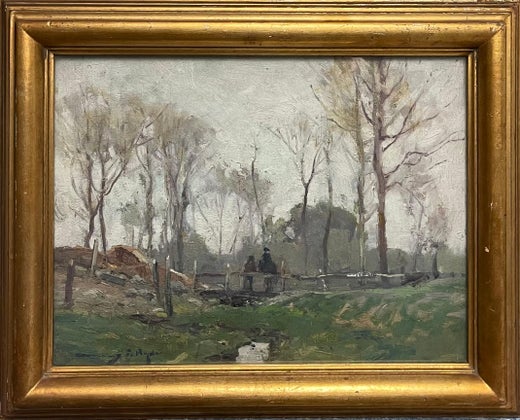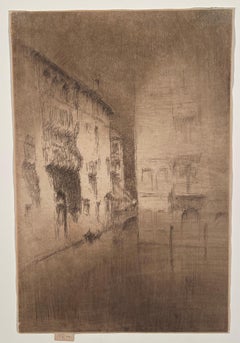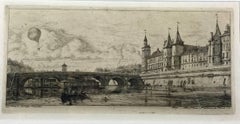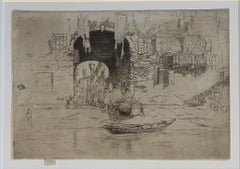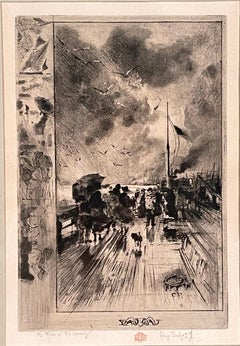Want more images or videos?
Request additional images or videos from the seller
1 of 5
Chauncey Foster RyderWINDSWEPT TREEScirca 1920
circa 1920
Price:$675
$875List Price
About the Item
- Creator:Chauncey Foster Ryder (1868-1949, American)
- Creation Year:circa 1920
- Dimensions:Height: 16 in (40.64 cm)Width: 20 in (50.8 cm)
- Medium:
- Period:
- Condition:
- Gallery Location:Portland, ME
- Reference Number:Seller: 108711stDibs: LU36736415772
Chauncey Foster Ryder
In 1907, Ryder moved to New York City, where he was represented for the rest of his career by art dealer William Macbeth. His landscapes were admired for their vigorous brushwork, and the degree to which he pushed representational elements towards abstraction. He became known for a palette of predominantly gray-green tones, eventually known as 'Ryder green'. He opened a studio in the city in 1909, and the following year bought property in Wilton, New Hampshire. For the remainder of his life, he divided his time between New York and New Hampshire. In 1910, he traveled throughout New England, providing locales for many of his subsequent paintings. That year, future president Woodrow Wilson and his wife Ellen bought one of his landscapes, Valley of Assisi, to celebrate their 25th wedding anniversary. Ryder was a member of several art associations, including the American Water Color Society and the Society for Sanity in Art. Among his awards were the Paris Salon (honorable mention, 1907), the American Water Color Society (gold medal), the National Arts Club (gold medal), and the New York Water Color Society (gold medal). He also received awards at the 1915 Panama–Pacific International Exposition and the 1937 Paris International Exposition. Ryder died in Wilton, NH in 1949. His work is in the collections of numerous American museums, including the Metropolitan Museum of Art (New York), the Corcoran Gallery of Art and the National Portrait Gallery (Washington, D.C.), the Art Institute of Chicago (Illinois), and the Baltimore Museum of Art (Maryland)
About the Seller
5.0
Recognized Seller
These prestigious sellers are industry leaders and represent the highest echelon for item quality and design.
Gold Seller
Premium sellers maintaining a 4.3+ rating and 24-hour response times
Established in 1966
1stDibs seller since 2016
363 sales on 1stDibs
Typical response time: 2 hours
Associations
International Fine Print Dealers Association
Authenticity Guarantee
In the unlikely event there’s an issue with an item’s authenticity, contact us within 1 year for a full refund. DetailsMoney-Back Guarantee
If your item is not as described, is damaged in transit, or does not arrive, contact us within 7 days for a full refund. Details24-Hour Cancellation
You have a 24-hour grace period in which to reconsider your purchase, with no questions asked.Vetted Professional Sellers
Our world-class sellers must adhere to strict standards for service and quality, maintaining the integrity of our listings.Price-Match Guarantee
If you find that a seller listed the same item for a lower price elsewhere, we’ll match it.Trusted Global Delivery
Our best-in-class carrier network provides specialized shipping options worldwide, including custom delivery.You May Also Like
Querelle d'amoureux. (Quarreling). 1
By James Tissot
Located in Storrs, CT
En plein soleil. (In the Sunlight). 1881. Etching and drypoint. Tissot 54, Béraldi 45, Wentworth 54. 7 13/16 x 11 1/2 (sheet 11 1/4 x 15). Edition about 100. Mat line and two hinge s...
Category
19th Century Impressionist Figurative Prints
Materials
Drypoint, Etching
$2,800 Sale Price
20% Off
H 7.82 in W 8.5 in D 0.5 in
The Bridge, Santa Maria
By James Abbott McNeill Whistler
Located in New York, NY
James Whistler (1834-1903), The Bridge, Santa Marta, 1879-80, etching with drypoint, printed in sepia on fine laid paper. Signed with the butterfly and inscribed imp on the tab (also with an exceedingly light butterfly lower right in the plate). Kennedy 204, probably eighth (final) state; Glasgow 201, probably state 9 (of 9) (cf. Margaret F. MacDonald, Grischka Petri, Meg Hausberg, and Joanna Meacock, James McNeill Whistler: The Etchings, a catalogue raisonné, University of Glasgow, 2011), Lochnan 199. Trimmed to the platemark by the artist, h: 11.8 x w: 7.9 in / h: 30 x w: 20.1 cm.
A fine impression, printed with subtle tone.
The bridge theme occurs repeatedly in Whistler’s vistas. It is also the main focus of more than one of the Venetian prints. While some bridges are seen from below, from where one would see it if approaching in a gondola (for example Ponte del Piovan, Kennedy 209), The Bridge depicts the scene from a high perspective, opening up the view into the far distance. The small boat approaching the arch in the foreground is again, as in the earlier Thames prints, a stock motif that is probably ultimately derived from the Japanese woodcuts of Hokusai and Hiroshige. The bridge here is the Ponte de le Terese over the Rio de l’Arzere in the Santa Marta quarter.
The early biography of Whistler by Elizabeth and Joseph Pennell is essential for its “immense quantity of information” but also notorious for “the inherent hyperbole and misinformation” (Eric Denker, Annotated Bibliography, in Fine, p. 184). Still, it is worth quoting from the Pennels’ appraisal of The Bridge: “Simplicity of expression has never been carried further. Probably the finest plate, in its simplicity and directness, is The Bridge. Whistler now obtained the quality of richness by suggesting detail, and also by printing. In The Traghetto...
Category
1870s Impressionist Landscape Prints
Materials
Drypoint, Etching
The Mill, Amsterdam, 1889
By James Abbott McNeill Whistler
Located in New York, NY
James Whistler (1834-1903), The Mill, 1889, etching and drypoint, signed in pencil with the butterfly on the tab and inscribed “imp”, and inscribed “first state” (twice) and annotated “Wunderlich” and signed again with the butterfly verso. Reference: Kennedy 413, first state (of 5). Glasgow 457, second state (of 6; see discussion below) (cf. Margaret F. MacDonald, Grischka Petri, Meg Hausberg, and Joanna Meacock, James McNeill Whistler: The Etchings, a catalogue raisonné, University of Glasgow, 2011)
On laid paper, in very good condition, trimmed just outside of the platemark all around except for the tab by the artist, 6 1/4 x 9 3/8 inches.
A very fine impression of this great rarity, printed in black/brown ink with a slight veil of plate tone.
provenance:
H. Wunderlich & Co., New York
Louis B. Dailey, New York (Lugt 4500)
sale, Sotheby’s, New York, October 31, 2003, lot 69
literature;
Neue Lagerliste 122: James McNeill Whistler – Etchings...
Category
1880s Impressionist Landscape Prints
Materials
Drypoint, Etching
Lagoon: Noon
By James Abbott McNeill Whistler
Located in New York, NY
James McNeill Whistler (1830-1903), Lagoon: Noon, etching and drypoint, 1879-1880, signed with the butterfly and inscribed “imp” on the tab [also signed with the butterfly in the plate lower left]. Reference: Glasgow 209, third state (of 3), Kennedy 216, third state (of 3); Lochnan 231, 4 7/8 x 7 7/8 inches.
A fine impression with very little plate tone, and printed with extraordinary attention to the etching and drypoint details. The printed butterfly, usually only barely visible, is clearly defined in this impression (see detail below). Kennedy mades special note that an impression like this, with the clearly visible butterfly, was in the collection of John H. Wrenn.
On a commission from the Fine Arts Society, Whistler created the plates of his Venice series...
Category
1870s Impressionist Landscape Prints
Materials
Drypoint, Etching
Hill River
By Wayne Thiebaud
Located in Palo Alto, CA
Created in 2002, this Wayne Thiebaud Hill River, 2002 drypoint and aquatint in color on wove paper is hand signed by Wayne Thiebaud (Mesa, 1920 - Sacramento, 2021) in pencil in the l...
Category
Early 2000s Modern Landscape Prints
Materials
Drypoint, Aquatint
Dark Hill River
By Wayne Thiebaud
Located in Palo Alto, CA
The Sacramento River deltas and levees near Thiebaud’s studio became a source of inspiration starting in the mid-1990s where he would sketch en plein air and then work combined ideas...
Category
Early 2000s Modern Landscape Prints
Materials
Engraving, Drypoint, Aquatint
San Marco [Venice].
By William Walcot R. E. Hon. R. I. B. A.
Located in Storrs, CT
William Walcot. R.E., R.I.B.A. San Marco. Etching with drypoint and aquatint. Dickins 66, Harvey-Lee 91. 3 7/8 x 5 7/8 (sheet 9 1/4 x 12 1/8). Venice set, # 2. Edition 415. A rich impression printed on cream wove paper. Fold in the margin, well outside the image; otherwise good condition. Signed in pencil. Housed in a 16 x 20-inch archival mat.
Soon after Walcot's arrival in England, the Fine Art Society sponsored a trip sent to Italy. This scene is one of four small drypoints that resulted from the artist’s stay in Venice.
When he was seventeen, he began to study architecture under Louis Benois at the Imperial Academy of Art in Saint Petersburg. He went to Paris where he continued his studies at the Ecole des Beaux-Arts and the Atelier Redon. He practiced as an architect briefly in Moscow, designing the Hotel Metropole...
Category
Early 20th Century Modern Landscape Prints
Materials
Drypoint, Etching, Aquatint
Chelsea Old Church, London
By William Walcot R. E. Hon. R. I. B. A.
Located in Storrs, CT
Chelsea Old Church. 1924. Etching, drypoint, and aquatint. Dickins 94. 5 3/8 x 8 (sheet 8 1/2 x 9 3/4). Edition 100 for The Print Collector's Club. A fine proof with tonal wiping, printed on cream wove paper. Signed and dedicated "W.R. Button from W. Walcot London 1930" in pencil.
Chelsea Old Church, also known as All Saints, is an Anglican church, on Old Church Street, Chelsea, London SW3, England, near Albert Bridge. It is the church for a parish in the Diocese of London, part of the Church of England. Inside the Grade I listed building, there is seating for 400 people. There is a memorial plaque to the author Henry James (1843–1916) who lived nearby on Cheyne Walk. To the west of the church is a small public garden containing a sculpture by Sir Jacob Epstein.
When he was seventeen,William Walcot began to study architecture under Louis Benois at the Imperial Academy of Art in Saint Petersburg. He went to Paris where he continued his studies at the Ecole des Beaux-Arts and the Atelier Redon. He practiced as an architect briefly in Moscow, designing the Hotel Metropole...
Category
Early 20th Century Modern Landscape Prints
Materials
Drypoint, Etching, Aquatint
$400 Sale Price
20% Off
H 5.38 in W 8 in D 0.5 in
Guardians of the Spire; Amiens Cathedral Number 2
By John Taylor Arms
Located in Middletown, NY
Guardians of the Spire; Amiens Cathedral Number 2
New York: 1937. Etching and drypoint on watermarked F.J. Head cream-colored, antique laid paper, 6 3/4 ...
Category
Mid-20th Century American Modern Figurative Prints
Materials
Drypoint, Etching
Palazzo dell'Angelo
By John Taylor Arms
Located in Middletown, NY
Palazzo dell'Angelo
1931
Etching and drypoint on cream-colored, handmade laid paper with deckle edges, 7 1/4 x 6 3/4 inches (185 x 171 mm), edition of 100, full margins. Signed, dated and numbered "Ed. 100" in pencil, lower margin, second state (of three). Printed by Henry Carling, New York. Extremely minor mat tone and some inky residue in the top right corner, all unobtrusive and well outside of image area. An exquisite impression of this intricate image, with astonishing detail, and all the fine lines printing clearly. The image represents the first print which Arms printed on his own handmade paper. Framed handsomely with archival materials and museum grade glass in a wood gilt frame with a flower and garland motif.
Illustrated: Dorothy Noyes Arms, Hill Towns and Cities of Northern Italy, p. 180; Anderson, American Etchers Abroad 1880-1930; Eric Denker, Reflections & Undercurrents: Ernest Roth and Printmaking in Venice, 1900-1940, p. 116.
[Fletcher 233]
Born in 1887 in Washington DC, John Taylor Arms studied at Princeton University, and ultimately earned a degree in architecture at the Massachusetts Institute of Technology in 1912. With the outbreak of W.W.I, Arms served as an officer in the United States Navy, and it was during this time that he turned his focus to printmaking, having published his first etching in 1919. His first subjects were the Brooklyn Bridge, near the Navy Yard, and it was during his wartime travel that Arms created a series of extraordinarily detailed etchings based on Gothic cathedrals and churches he visited in France and Italy. He used what was available to him, namely sewing needles and a magnifying glass, to create the incredibly rich and fine detail that his etchings are known for. Upon his return to New York after the war, Arms enjoyed a successful career as a graphic artist, created a series of etchings of American cities, and published Handbook of Print Making and Print Makers (Macmillan, 1934). He served as President of the Society of American Graphic Artists, and in 1933, was made a full member of the National Academy of Design.
In its most modern incarnation, Palazzo dell'Angelo was constructed in or around 1570. The building, which has a rich and storied history, was erected upon the ruins of an earlier structure which predates the Gothic period. Some remnants of the earliest features of the residence were most certainly still visible when Arms visited, as they are today. Having a background in architecture, there's no question that Arms was moved by the beauty, history and ingenuity represented in the physical structure. One thing specifically gives away Arms's passion for the architecture, and that is the fact that he focused on the building's Moorish entranceway, balustrade, and two mullioned windows, and not on the curious Gothic era bas-relief of an angel nestled into the facade of the building, after which the structure is named. The sculpture itself doesn't appear in Arms's composition at all, despite the fact that it is the feature of the building that is most famous in its folklore. Arms instead focuses on the oldest portion of the architecture, even documenting some of the remnants of a fresco, and a funerary stele for the freedman Tito Mestrio Logismo, and his wife Mestria Sperata (visible above the water level, to the left of the door, behind the gondola), which was first described in 1436.
Among the many notable bits of history regarding the Palazzo, it has been documented that Tintoretto painted frescos of battle scenes on the facade of the building. The paintings have been lost to time and the elements, but not entirely to history. The empty frame...
Category
1930s American Modern Figurative Prints
Materials
Drypoint, Etching
More From This Seller
View AllNOCTURNE: PALACES
By James Abbott McNeill Whistler (circle)
Located in Portland, ME
Whistler, James A. M. NOCTURNE: PALACES. Glascow 200, Kennedy 202. Etching and drypoint with platetone, 1879-80. From the Second Venice Set. Signed on the tab with the butterfly in pencil. Printed in sepia on laid paper with no visible watermark. Trimmed just outside the platemark, leaving the tab. In excellent condition. As with all of the Whistler Nocturnes, each impressions of this print is different, dependng on how Whistler wiped and manipulated the platetone. 11 5/8 x 7 7/8 inches (plate and sheet, plus the tab). Framed to 20 x 16 inches.
Provenance: Collection of Thomas Jefferson Coolidge, Jr. with his collection stamp (Lugt 1429) verso; Kennedy Galleries, with its inventory number a65609 in pencil verso, and with another inscription, "FWCX" in pencil, verso.
Thomas Jefferson Coolidge, 1831-1920, was a great-grandson of Thomas Jefferson, a powerful Boston businessman, and an Ambassador to France.
In 1875 he became the manager of the largest textile mill in America, the Amoskeag Mill in Manchester New Hampshire, and had major financial interests in the textile, banking, railroad, publishing and electrical industries. In 1880 he became the President of the Atchison, Topeka & Santa Fe Railway. He was one of the founders of the United Fruit Company...
Category
1870s Landscape Prints
Materials
Drypoint, Etching
LE PONT AU CHANGE
By Charles Meryon
Located in Portland, ME
Meryon, Charles. LE PONT AU CHANGE. S.40(v), DW.34. Etching with drypoint, 1854. Fifth State of twelve, with the inscriptions in cursive, "C. Meryon del. sculp. mdcccliiii," lower l...
Category
1850s Realist Landscape Prints
Materials
Drypoint, Etching
SAN BIAGIO
By James Abbott McNeill Whistler
Located in Portland, ME
Whistler, James A. M. SAN BIAGIO. Etching and Drypoint, 1880. Glascow 237, K.197; M.194; W.163. State 8 of 17. With the printed butterfly at left, and with the butterfly signature in...
Category
1880s Landscape Prints
Materials
Drypoint, Etching
UNE JETEE EN ANGLETERRE
By Félix Hilaire Buhot
Located in Portland, ME
Buhot, Felix (French, 1847-1898). UNE JETEE EN ANGLETERRE. B & G 132, State two of eight. Etching with drypoint, aquatint and roulette, 1879. Signed in pencil, and with the red owl...
Category
1870s Landscape Prints
Materials
Drypoint, Etching, Aquatint
QUARTER OF NINE - SATURDAY'S CHILDREN
By Martin Lewis
Located in Portland, ME
Lewis, Martin (American, born Australia, 1881-1962). QUARTER OF NINE, SATURDAY'S CHILDREN. McCarron 79. Drypoint, 1929. McCarron says the intended edition was 100 , but 107 were prin...
Category
1920s Landscape Prints
Materials
Drypoint
THE TRAWLERS
By George Elmer Browne
Located in Portland, ME
Browne, George Elmer (American, 1871-1946). THE TRAWLERS. Drypoint, not dated. Edition size not stated. Titled and signed in pencil. In excellent condition.
Category
20th Century Landscape Prints
Materials
Drypoint
Still Thinking About These?
All Recently ViewedMore Ways To Browse
Gavin Brown
Gummy Bear Art
Havdalah Spice
Infinity Nets
Jonas Noel Niedermann
Jose Clara
Kaws Passing Through
Lady And The Tramp Vintage
Large Outdoor Bronze Sculptures
Lyme Regis
Origami Sculpture
Original Comic Art
Pablo Picasso Bird
Picasso Terracotta
Rca Antique
Robert Moses
Saint George Sculpture
San Juan Capistrano
